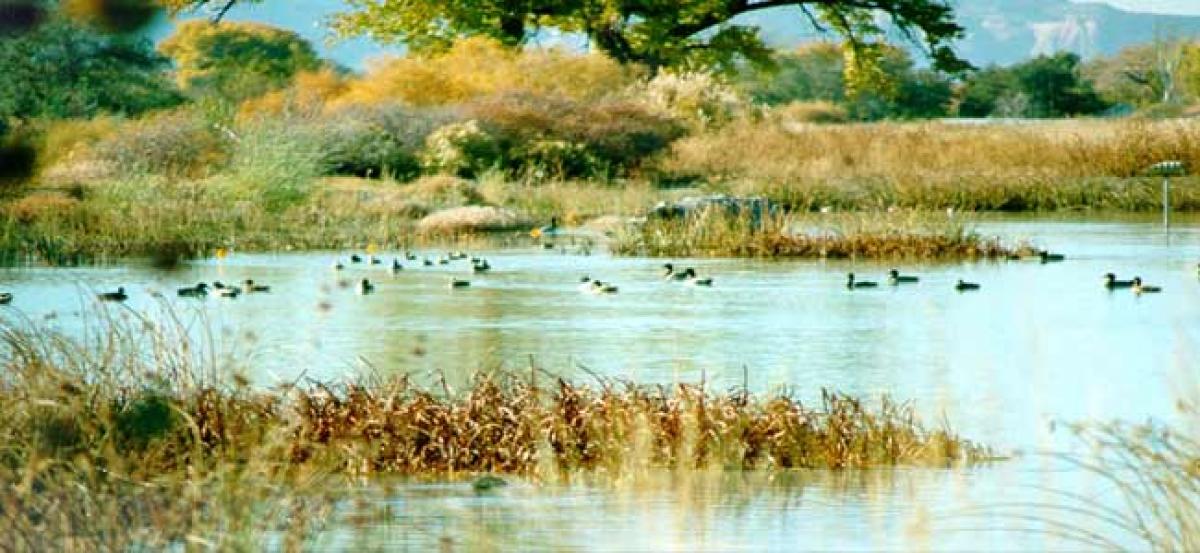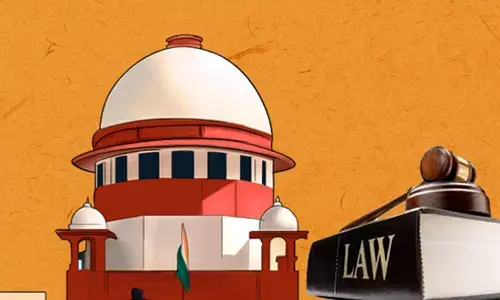Safeguarding wetlands

A judgment by the Uttarakhand High Court, stating that Ganga and Yamuna rivers are “living entities”, captured the national imagination. It is worth noting that
A judgment by the Uttarakhand High Court, stating that Ganga and Yamuna rivers are “living entities”, captured the national imagination. It is worth noting that wetlands, the other major water-based ecosystem apart from rivers, are at a moment of policy transition in the country.
This year, a new legal framework for wetlands was passed, the Wetland (Conservation and Management) Rules, 2017, replacing the earlier Rules of 2010 which prohibit a range of activities in wetlands like setting up and expansion of industries, waste dumping and discharge of effluents.
Also this year, the Supreme Court passed an order directing States to identify wetlands in the country within a stipulated timeframe.
Wetland
- Wetland is transitional land between terrestrial and aquatic eco-systems where water table is usually at or near surface or it may be land covered by shallow water.
- It supports rich biodiversity and provides wide range of ecosystem services such as water storage, water purification, flood mitigation, erosion control, aquifer recharge etc.
- It means an area of marsh, fen, peat land or water; whether natural or artificial, permanent or temporary, with water that is static or flowing, fresh, brackish or salt, including areas of marine water the depth of which at low tide does not exceed six meters, but does not include river channels, paddy fields, human-made water bodies/tanks specifically constructed for drinking water purposes and structures specifically constructed for aquaculture, salt production, recreation and irrigation purposes.
- There are 115 wetlands officially identified by Central Government and of those 26 are identified as wetlands of international importance under Ramsar Convention (an international intergovernmental treaty for conservation of wetlands to which India is party).
Safeguarding wetlands
- Wetlands, vital parts of the hydrological cycle, are highly productive ecosystems which support rich biodiversity and provide a wide range of ecosystem services such as water storage, water purification, flood mitigation, erosion control, aquifer recharge, microclimate regulation, aesthetic enhancement of landscapes while simultaneously supporting many significant recreational, social and cultural activities, being part of our rich cultural heritage; Wetlands are threatened
by various causes
- Many wetlands are threatened by reclamation and degradation through drainage and landfill, pollution (discharge of domestic and industrial effluents, disposal of solid wastes), hydrological alteration (water withdrawal and changes in inflow and outflow), over-exploitation of their natural resources resulting in loss of biodiversity and disruption in ecosystem services provided by wetlands.
- Article 51A of the Constitution stipulates that it shall be the duty of every citizen of India to protect and improve the natural environment including forests, lakes, rivers and wildlife and to have compassion for living creatures;
- The Environment (Protection) Act, 1986 is a comprehensive legislation to provide protection and improvement of the environment, including inter-alia, wetlands, and for matters connected therewith;
- National Environment Policy, 2006 recognizes the ecosystem services provided by wetlands and emphasizes the need to set up a regulatory mechanism for all wetlands so as to maintain their ecological character, and ultimately support their integrated management;
- India is a signatory to the Ramsar Convention on Wetlands and is committed to conservation and wise use of all wetlands within its territory;
- Conservation and wise use of wetlands can provide substantial direct and indirect economic benefits to state and national economy, and thereby the Central Government stands committed to mainstreaming full range of wetland biodiversity and ecosystem services in development planning and decision making for various sectors.
- The Central Government considered it necessary to supersede the Wetlands (Conservation and Management) Rules, 2010 for effective conservation and management of wetlands in the country.
Highlights of wetlands (Conservation and Management) Rules, 2017
State Wetlands Authority (SWA)
- It stipulates setting up of SWA in each State/UTs headed by State’s environment minister and include range of government officials. State government will also nominate one expert each in fields of wetland ecology, hydrology, fisheries, landscape planning and socioeconomics.
Functions of SWA
- It will develop comprehensive list of activities to be regulated and permitted within notified wetlands and their zone of influence.
- It will also recommend additional prohibited activities for specific wetlands define strategies wise use of wetlands and its conservation and undertake measures to enhance awareness within stakeholders and local communities on values and functions of wetlands.
- In this case, wise use has been defined as principle of sustainable uses that is compatible with conservation.
Prohibited Activities
- The rules prohibit activities like conversion of wetland for non-wetland uses including encroachment of any kind, setting up and expansion of industries, waste dumping and discharge of untreated wastes and effluents from industries, cities, towns, villages and other human settlements.
Digital inventory of all wetlands
- It is mandatory for state authorities to prepare list of all wetlands and list of wetlands to be notified within six months. Based on it, a comprehensive digital inventory of all wetlands will be created and will be updated every ten years.
National Wetlands
Committee (NWC)
- The rules stipulates for setting up of NWC, headed by MoEFCC Secretary, to monitor implementation of these rules and oversee work carried out by States.
- NCW will also advise Central Government on appropriate policies and action programmes for conservation and wise use of wetlands, recommend designation of wetlands of international importance under Ramsar Convention, advise on collaboration with international agencies on issues related to wetlands etc.
Comparing 2010 and 2017 Rules
- The 2010 and 2017 Rules for wetlands both emphasise that the ecological character of wetlands ought to be maintained for their conservation.
- ‘Ecological character’ refers to processes and components which make the wetland a particular, and sometimes unique, ecosystem. For example, as lagoons like Chilika (Odisha) and Pulicat (Tamil Nadu/Andhra Pradesh) are characterised by a mix of saline and fresh water, the flows of each type need to be maintained; river flood plains contain wetlands that require conservation so they can re-fuel the river with fish and other aquatic life during flooding.
- In the 2010 Rules, some related criteria were made explicit, such as natural beauty, ecological sensitivity, genetic diversity, historical value, etc. These have been omitted in the 2017 Rules.
Reasons for problematic
- There are multiple interests around wetlands. Multiple interests also have governance needs, and this makes it absolutely necessary to identify and map these multiple uses.
- It is crucial to identify ecological criteria so that the wetlands’ character can be maintained. The key to wetland conservation is not just understanding regimes of multiple uses — but conserving or managing the integrity of the wetland ecosystem.
- Finally, restriction of activities on wetlands will be done as per the principle of ‘wise use’, determined by the State wetland authority. Whether wise use will include maintaining ecological character remains to be seen.
- Under the new Rules, no authority to issue directions, which are binding in nature to desist from any activity detrimental to wetland conservation, has been prescribed to State wetland authorities.
- Salt pans as ‘wetlands’ have been omitted from the new Rules. They were identified as wetlands in the 2010 Rules, as they are often important sites of migratory birds and other forms of biodiversity.
The case of Deepor Beel
- The issue of wetlands being multiple-use found centre-stage this year with the observations of the National Green Tribunal (NGT) in the case of Deepor Beel.
- Deepor Beel is a Ramsar site and a part of it is also wildlife sanctuary in Guwahati, Assam. This wetland harbours a wide variety of biodiversity, and also suffers from intense man-made pressure — the city’s municipal waste is dumped close to the Beel.
- Large, meat-eating storks (Greater adjutant storks) are ironically found eating from the mountains of garbage at the site. Potential impacts of contamination or poisoning from the garbage are still unknown.
- This January, 26 storks died. The fact that Deepor Beel exists as a wetland does not prevent garbage dumping; this is a fate faced by many wetlands.
- The NGT’s observations on Deepor Beel are interesting and symptomatic of what is happening in several wetlands.
- In an inspection done by the judicial member of the Tribunal, it was noted that waste was being dumped “not beyond the site but within it,” and “demarcations are made by drying out areas or cutting off water sources”. These are classic ways of killing a wetland and turning it from a wet to a dry ecosystem; or from a lake to a garbage dump or cesspool. The Tribunal has now asked for the “traditional” spread of the wetland.
Way forward
- Given all the modern uses of wetlands, looking at traditional cartography may be one way to understand catchments of wetlands.
- It may also be a way of restoring some modicum of ecological character, identity or ‘rights’ to wetlands, as the river judgment suggested.
- There are challenges ahead in identifying wetlands – multiple and competing use is just one of them.
- Understanding the historic spread and ecological character will be an important safeguard for the way forward. Setting clear governance systems would be the next.
Gudipati Rajendera Kumar




